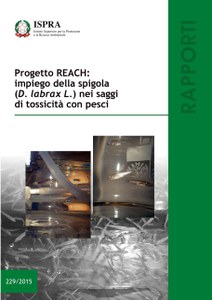REACH project: the use of the European Sea Bass (D. Labrax L.) in the fish toxicity testing
Ecotoxicological testing of fish are widely employed for assessing the toxicity of chemical substances, environmental samples and wastes. Among different factors driving fish species selection for toxicity testing (size, ease of maintenance in the laboratory, convenience for testing, relevant economic, known sensitivity, pre-existing data, etc.), the national or regional preferences are also important.European sea bass (Dicentrarchus labrax Linnaeus 1758) is one of the most extensively reared marine fishes in the Mediterranean basin (Italy, Spain, France, Greece, Turckey, and North Africa). The high availability at every stage of the reproductive cycle gives the opportunity to employ the sea bass as test organism to assess toxicity of chemicals and/or to define environmental quality standard.
The report ISPRA is aimed to well-document the use of the marine species Dicentrarchus labrax for fish toxicity testing. To acquire data, we consulted the ECOTOXicology database (EPA ECOTOX version 4), PubMed and Google Web Search for the years 1990 – 2013. Among the 126 scientific articles selected on this species, thirty-four of them, concerning toxicity studies, were considered for reviewing. The chemicals assessed for toxicity were the following: heavy metals; anionic surfactants; aromatic hydrocarbons; halchil halides; diethylene glycol; 2 phenoxyethanol; pesticides; mycotoxins; inorganic compounds, citotoxics, and oil dispersants. Other toxicity evaluations on sea bass concerning Produced Formation Waters, marine sediments, oil wathering, and marine microalgae, were also considered. Of the toxicity studies reviewed, twenty-eight studies concerned the acute toxicity test (24, 48, 72 and 96 hours), eleven studies also evaluated the prolonged toxicity (7, 14, 28 days), and one only study concerned the sub-lethal effects (growth).
A comparison between Dicentrarchus labrax and other marine and freshwater fish species is presented.
Dowload the publication ( pdf - 4.3 mb)

